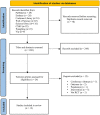Non-invasive brain stimulation associated mirror therapy for upper-limb rehabilitation after stroke: Systematic review and meta-analysis of randomized clinical trials
- PMID: 35928134
- PMCID: PMC9345505
- DOI: 10.3389/fneur.2022.918956
Non-invasive brain stimulation associated mirror therapy for upper-limb rehabilitation after stroke: Systematic review and meta-analysis of randomized clinical trials
Abstract
Background: Non-invasive brain stimulation (NIBS) techniques and mirror therapy (MT) are promising rehabilitation measures for stroke. While the combination of MT and NIBS has been employed for post-stroke upper limb motor functional rehabilitation, its effectiveness has not been examined.
Objective: This study aimed to evaluate the effectiveness of combined MT and NIBS in the recovery of upper limb motor function in stroke patients.
Methods: The search was carried out in PubMed, EMBASE, Cochrane Library, Web of Science, Science Direct, CNKI, WANFANG and VIP until December 2021. Randomized clinical trials (RCTs) comparing MT or NIBS alone with the combination of NIBS and MT in improving upper extremity motor recovery after stroke were selected. A meta-analysis was performed to calculate the mean differences (MD) or the standard mean differences (SMD) and 95% confidence intervals (CI) with random-effect models. Subgroup analyses were also conducted according to the types of control group, the types of NIBS, stimulation timing and phase poststroke.
Results: A total of 12 articles, including 17 studies with 628 patients, were reviewed in the meta-analysis. In comparison with MT or NIBS alone, the combined group significantly improved body structure and function (MD = 5.97; 95% CI: 5.01-6.93; P < 0.05), activity levels (SMD = 0.82; 95% CI 0.61-1.02; P < 0.05). For cortical excitability, the motor evoked potential cortical latency (SMD = -1.05; 95% CI:-1.57--0.52; P < 0.05) and the central motor conduction time (SMD=-1.31 95% CI:-2.02--0.61; P < 0.05) of the combined group were significantly shortened. A non-significant homogeneous summary effect size was found for MEP amplitude (SMD = 0.47; 95%CI = -0.29 to 1.23; P = 0.23). Subgroup analysis showed that there is an interaction between the stimulation sequence and the combined treatment effect.
Conclusion: In this meta-analysis of randomized clinical trials, in comparison to the control groups, MT combined with NIBS promoted the recovery of upper extremity motor function after stroke, which was reflected in the analysis of body structure and function, activity levels, and cortical excitability.
Systematic review registration: https://www.crd.york.ac.uk/prospero/, identifier CRD42022304455.
Keywords: meta-analysis; mirror therapy (MT); non-invasive brain stimulation (NIBS); repetitive transcranial magnetic stimulation (rTMS); stroke; transcranial direct current stimulation (tDCS); upper motor function.
Copyright © 2022 Zhao, Li, Liu, Mei, Guo, Liu, Tao and Ma.
Figures








Similar articles
-
Examining the effectiveness of motor imagery combined with non-invasive brain stimulation for upper limb recovery in stroke patients: a systematic review and meta-analysis of randomized clinical trials.J Neuroeng Rehabil. 2024 Nov 30;21(1):209. doi: 10.1186/s12984-024-01491-x. J Neuroeng Rehabil. 2024. PMID: 39616389 Free PMC article.
-
Excitatory Repetitive Transcranial Magnetic Stimulation Over the Ipsilesional Hemisphere for Upper Limb Motor Function After Stroke: A Systematic Review and Meta-Analysis.Front Neurol. 2022 Jun 20;13:918597. doi: 10.3389/fneur.2022.918597. eCollection 2022. Front Neurol. 2022. PMID: 35795793 Free PMC article.
-
Comparison of the effects of transcranial direct current stimulation combined with different rehabilitation interventions on motor function in people suffering from stroke-related symptoms: a systematic review and network meta-analysis.Front Neurol. 2025 Jun 4;16:1586685. doi: 10.3389/fneur.2025.1586685. eCollection 2025. Front Neurol. 2025. PMID: 40534746 Free PMC article.
-
Efficacy of non-invasive brain stimulation for post-stroke sleep disorders: a systematic review and meta-analysis.Front Neurol. 2024 Oct 30;15:1420363. doi: 10.3389/fneur.2024.1420363. eCollection 2024. Front Neurol. 2024. PMID: 39539650 Free PMC article.
-
Impact of the combination of virtual reality and noninvasive brain stimulation on the upper limb motor function of stroke patients: a systematic review and meta-analysis.J Neuroeng Rehabil. 2024 Oct 5;21(1):179. doi: 10.1186/s12984-024-01474-y. J Neuroeng Rehabil. 2024. PMID: 39369259 Free PMC article.
Cited by
-
From Molecule to Patient Rehabilitation: The Impact of Transcranial Direct Current Stimulation and Magnetic Stimulation on Stroke-A Narrative Review.Neural Plast. 2023 Feb 28;2023:5044065. doi: 10.1155/2023/5044065. eCollection 2023. Neural Plast. 2023. PMID: 36895285 Free PMC article. Review.
-
Improving Upper Limb and Gait Rehabilitation Outcomes in Post-Stroke Patients: A Scoping Review on the Additional Effects of Non-Invasive Brain Stimulation When Combined with Robot-Aided Rehabilitation.Brain Sci. 2022 Nov 7;12(11):1511. doi: 10.3390/brainsci12111511. Brain Sci. 2022. PMID: 36358437 Free PMC article.
-
Effects of a single tDCS with mirror therapy stimulation on hand function in healthy individuals.Front Hum Neurosci. 2025 Jun 18;19:1607022. doi: 10.3389/fnhum.2025.1607022. eCollection 2025. Front Hum Neurosci. 2025. PMID: 40606492 Free PMC article.
-
Examining the effectiveness of motor imagery combined with non-invasive brain stimulation for upper limb recovery in stroke patients: a systematic review and meta-analysis of randomized clinical trials.J Neuroeng Rehabil. 2024 Nov 30;21(1):209. doi: 10.1186/s12984-024-01491-x. J Neuroeng Rehabil. 2024. PMID: 39616389 Free PMC article.
-
Effect of motor process-related priming via repeated transcranial magnetic stimulation on embodiment perception during mirror visual feedback: a pilot study.Front Neurosci. 2024 Nov 26;18:1501169. doi: 10.3389/fnins.2024.1501169. eCollection 2024. Front Neurosci. 2024. PMID: 39659886 Free PMC article.
References
Publication types
LinkOut - more resources
Full Text Sources

